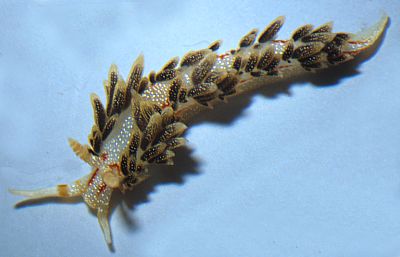
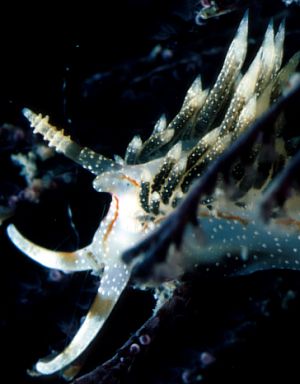
Phidiana anulifera
(Baba, 1949)
Order: NUDIBRANCHIA
Suborder: AEOLIDINA
Family: Glaucidae
DISTRIBUTION
Known from Japan & Hong Kong.
PHOTO
Hong Kong Workshop, April 1983, AM C139047
UPPER: Photo: Brian Darvell. LOWER: Head, showing orange-red markings and annulate rhinophores. Note left rhinophore missing. Photo: Bernard Picton.
Body translucent white with a close sacttering of opaque white specks. The oral tentacles have a broad reddish orange band near the base, and sometimes another near the tip. The region between these bands is opaque white, the tip teranslucent clear. The rhinophores have a about six, distinct and sharply edged annuli. Below the annuli the rhinophores stalk is translucent clear with scattered white specks. The annulate region is opaque white and the tip translucent clear. On the head there is a pair of thin orange-red lines which run from the inside base of the oral tentacles back to the rhinophores. A continuation of these lines runs around the back of the rhinophores and down to the first ceratal group on each side. This red-orange line reappears along the side of the body between each ceratal cluster. It also runs a short distance from the last ceratal cluster back on to the posterior foot. The cerata are translucent celar with white specks arranged in parallel lines along the cerata. The digestive gland gives the cerata a black appearance. Grows up to 10mm long.
It has similarities in colour and shape to Phidiana semidecora (Pease, 1860) from Hawaii and some authors have suggested they are the same species. This may be so but there are apparently consistent differences in colour. Although P. semidecora is reported to have orange markings on the head, they are never reported as a pair of lines as in P. anulifera and the Hawaiian species does not seem to have orange lines down the sides of the body between the ceratal clusters. There is also no report of rows of white specks on the cerata. At this stage I think we need to know a bit more about both species before we synonymise them.
References:
• Baba, K (1949) Opisthobranchia of Sagami Bay collected by His Majesty The Emperor of Japan. Iwanami Shoten, Tokyo. 194pp., 50 Pls
• Gosliner, T.M. (1979) The systematics of the Aeolidiacea (Nudibranchia: Mollusca) of the Hawaiian Islands, with descriptions of two new species. Pacific Science, 33(1): 37-77.
Rudman, W.B., 2001 (August 9) Phidiana anulifera (Baba, 1949). [In] Sea Slug Forum. Australian Museum, Sydney. Available from http://www.seaslugforum.net/find/phidanul
Related messages
Phidiana anulifera from Ratnagiri, India
June 2, 2009
From: Vishal Bhave
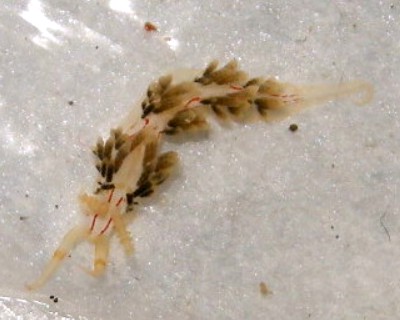
Concerning message #22326:
It was found a rockpool, at lowtide. Rockpool with lots small Rock Pebbles. it was found under the pebble and in a shadowed area of pool. many rocks were encrusted with hydroids and wall of rockpool was full of hydroids, bryozoans and other small encrusting animals.
Locality: Rock patch, Mandavi, Ratnagiri , 0.8 feet, Maharashtra, India, Arabian sea , 27 May 2009, Intertidal, shallow rockpool with rock pebbles at bottom. Length: 12 mm. Photographer: Vishal Bhave.
vishalbhave@gmail.com
Bhave, V.J., 2009 (Jun 2) Phidiana anulifera from Ratnagiri, India. [Message in] Sea Slug Forum. Australian Museum, Sydney. Available from http://www.seaslugforum.net/find/22508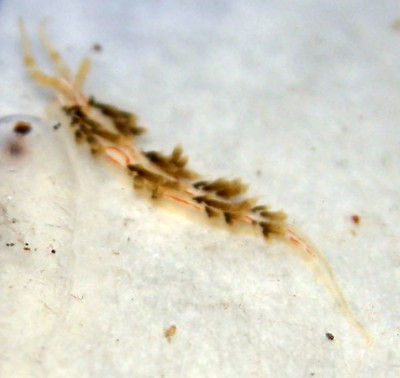
Dear Vishal,
Thanks for another record of Phidiana anulifera.
Best wishes,
Bill Rudman
Phidiana anulifera from Ratnagiri, India
March 16, 2009
From: Vishal J. Bhave.
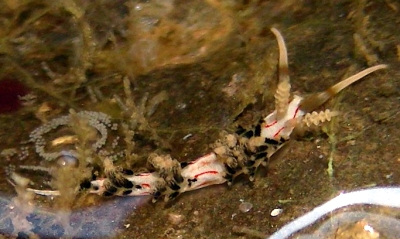
From its morphology it looks like Phidiana anulifera but I need further help.
It was found a rockpool, at lowtide. The rockpool was full of small rocks and it was found under one in a shadowed area of pool. Some rocks were encrusted with hydroids and wall of rockpool was full of hydroids, bryozoans, some small molluscs and sponges.
Locality: Black sea, Mandvi, Ratnagiri, 0.5 feet, Maharashtra, India, Arabian Sea / Indian ocean, 08 February 2009, Rock pool, rocky substratum, Intertidal,. Length: 4-5 mm. Photographer: Vishal Bhave.
Vishal Bhave
vishalbhave@gmail.com
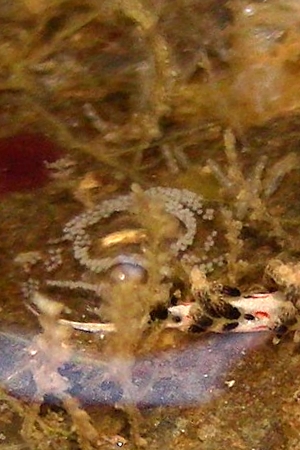
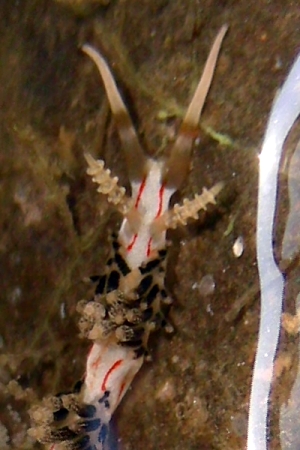
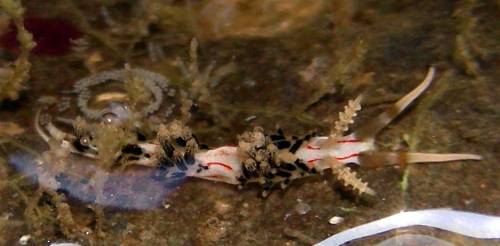
Dear Vishal,
This is a very interesting find. Your animal certainly looks like Phidiana anulifera except that the body is opaque white while in other examples the body is translucent clear with a scattering of opaque white spots. However I suspect your animals represent a colour variation in which the white spots merge to form a continuous white background. Not many aeolids have been described from India so I am pretty sure there is not an old name lurking around for this species. However it would not surprise me if Phidiana semidecora (Pease, 1860) which was first described from Hawaii, and Phidiana bourailli (Risbec, 1928), first described from New Caledonia, turned out to be synonyms of P. anulifera.
Another species it has a superficial resemblance to is Cratena simba (Edmunds, 1970) but the orange markings are arranged differently, and so are the groups of cerata.
The egg ribbon behind the animal in your photos could well belong to this animal. If an aeolid finds a large hydroid colony it will stay there until all polyps are eaten. Often you will find one or more of its egg ribbons nearby.
Best wishes,
Bill Rudman
Phidiana anulifera from Hong Kong
August 17, 2001
From: Leslie Chan
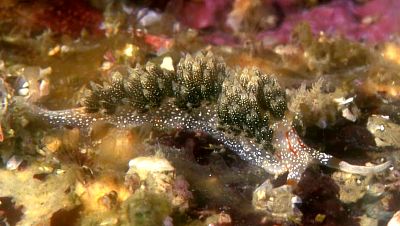
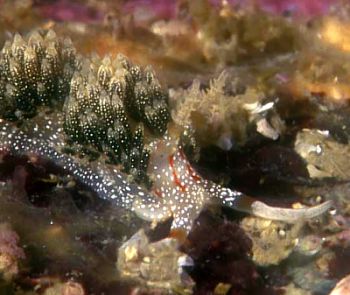
Dear Dr.Rudman
I have another nudibranch I need your help to ID again It is from:
Steep Island, Hong Kong, 12 m; 24 February 2001
Thank you very much
Leslie Chan
leslie@lesmart.com
Chan, L., 2001 (Aug 17) Phidiana anulifera from Hong Kong. [Message in] Sea Slug Forum. Australian Museum, Sydney. Available from http://www.seaslugforum.net/find/5071Thanks Leslie,
This is Phidiana anulifera which we have been comparing on the Forum with the Hawaiian species P. semodecora. It's nice to get another photo to confirm the consistency of the Hong Kong colour pattern.
Best wishes,
Bill Rudman.
Phidiana anulifera from Hong Kong
August 12, 2001
From: Bernard Picton
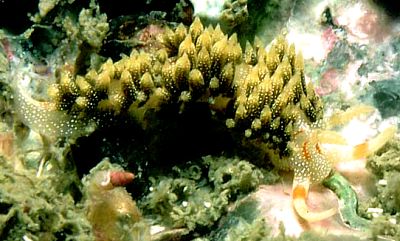
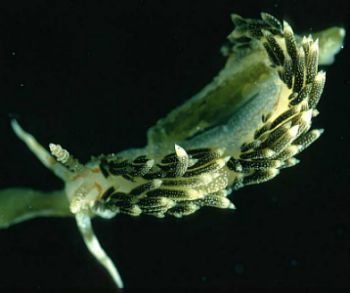
Hi Bill,
I have photos of something I labelled as Phidiana anulifera (Baba, 1949) from Hong Kong. I see that this is considered by some people to be synonymous with Facelinella semidecora (Pease, 1860) - illustrated in Bertsch and Johnson's Hawaiian Nudibranchs, 1981. Do you have an opinion on this one?
Bernard
bernard.picton.um@nics.gov.uk
Picton, B.E., 2001 (Aug 12) Phidiana anulifera from Hong Kong. [Message in] Sea Slug Forum. Australian Museum, Sydney. Available from http://www.seaslugforum.net/find/5053Dear Bernard,
I'm afraid I don't know enough about the Hawaiian Facelinella semidecora to be sure. From the published descriptions it seems to lack the red-orange lines of Phidiana anulifera and the rows of white specks on the cerata. My feeling is that they should be considered distinct until we know more about the colour variation in both species.
Cheers,
Bill Rudman
